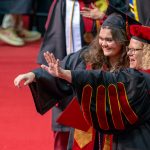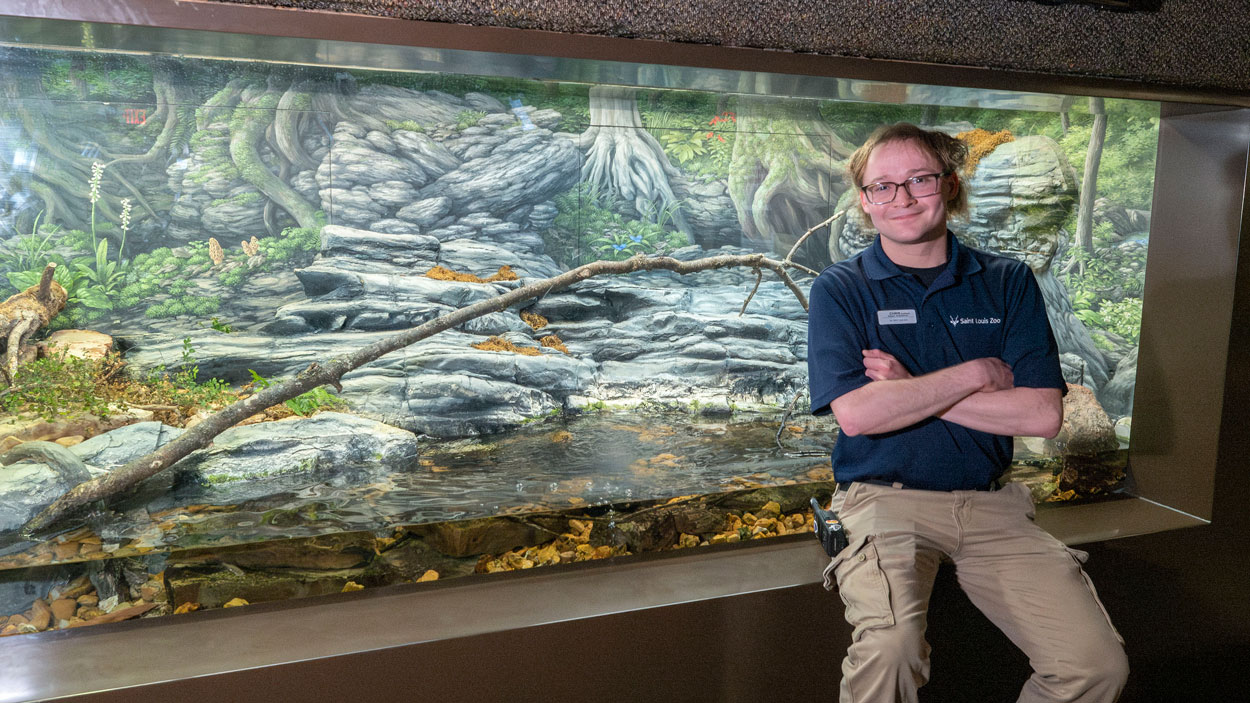
Chris Hollingsworth is a part-time hellbender keeper at the Saint Louis Zoo’s Ron and Karen Goellner Center for Hellbender Conservation. He earned his bachelor’s degree in biology at UMSL in 2023. (Photos by Derik Holtmann)
Chris Hollingsworth and his saxophone joined the crowd of University of Missouri–St. Louis students, faculty, staff and supporters filling the third floor-rotunda of the Millennium Student Center for a pep rally on Feb. 27.
The event served to build excitement for the homecoming basketball games being played later that evening against Drury and also provided an opportunity for the Department of Athletics to unveil its new logo showcasing UMSL’s friendly – but also fierce – amphibious mascot, Louie.
Hollingsworth, who earned his bachelor’s degree in biology in December 2023 but has remained in contact with the university through his involvement with the pep band, Triton Sound, joined his fellow bandmates in a musical performance that helped draw in the crowd and raise the energy level in the room. They then gave way to remarks from Chancellor Kristin Sobolik and Director of Athletics Holly Sheilley.
Just before revealing the new logo, Sheilley shared a bit about Louie and his history, as well as the role hellbender salamander conservation efforts at the Saint Louis Zoo played in inspiring his creation. That’s when Hollingsworth’s ears perked up.
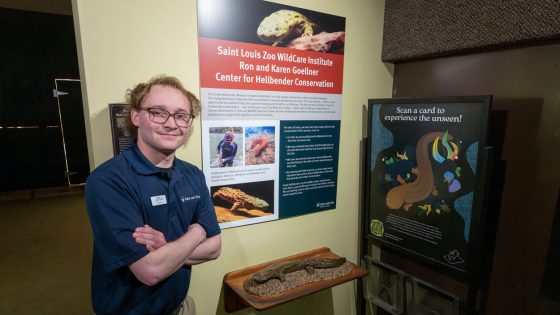
The Saint Louis Zoo’s Ron and Karen Goellner Center for Hellbender Conservation has been helping to protect and preserve hellbenders, which are the largest species of salamander native to North America.
“I was so excited,” he said. “I was like, ‘That’s my job. That’s what I do.’”
Since last September, Hollingsworth has served as a member of the animal care team at the zoo’s Ron and Karen Goellner Center for Hellbender Conservation. The center has spent more than two decades helping to protect and preserve hellbenders, which are the largest species of salamander native to North America and that have been living in Missouri’s fast-moving streams and waterways virtually unchanged for thousands of years.
The populations of both subspecies of hellbenders – the Eastern and the Ozark – have been in decline over the past four decades due to stream impoundments, disease, pollution and siltation. The center has worked in conjunction with the Missouri Department of Conservation and U.S. Fish and Wildlife Service to rear, breed and provide a head start for hellbenders so they can be released back into Missouri rivers and streams and help restore populations to pre-decline levels.
Taking great care
Hollingsworth joined the center in a part-time role and has been working and learning from four other full-time zookeepers since his hiring. He has a hand in feeding and caring for the hellbenders behind the scenes – ensuring that the artificial streams they inhabit are kept clean and in alignment with the conditions their brethren are experiencing around the state in their native waters.
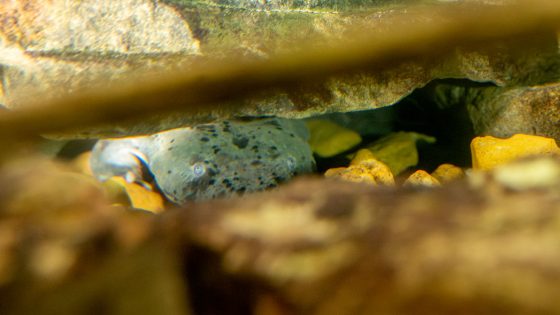
A hellbender peeks out from under a rock at the Saint Louis Zoo’s herpetarium. Missouri is the only state that is home to both the Eastern and Ozark subspecies of hellbenders, and the salamanders have been living in its fast-moving waters virtually unchanged for thousands of years.
“The conditions to get these animals to breed in captivity have to be very specific,” he said. “We have to make sure that the temperatures in our artificial streams match the temperatures that the rivers they came from in the wild are at any certain time of the year.”
The zookeepers are also tracking the pH balance in the water and how much sunlight and precipitation it receives in a given day. The Missouri Department of Conservation and state herpetologist Jeff Briggler keep tabs on conditions in rivers around the state, helping inform the animal care team’s work.
Hollingsworth said the zoo also takes extensive records on each of the animals, including how much and how often they eat, how much they weigh and any changes in size throughout their lives.
Throughout the winter, he and his colleagues kept close watch on the development of fertilized eggs that hellbenders laid last fall. This month, Hollingsworth expects to begin helping release some of the hellbenders to the wild.
“I’m going to be really excited,” he said. “It’s going to take a lot of planning.”
The zoo and its partners have released more than 10,000 hellbenders since first successfully breeding them under human care in 2011. In 2023, the team found zoo-raised and released hellbenders from both subspecies guarding a clutch of eggs in Missouri streams, offering proof that both are capable of reproducing in the wild after being released.
A path to a career
Hollingsworth feels fortunate to get to participate in these conservation efforts. He grew up in Hillsboro in Jefferson County and was a frequent visitor to the Saint Louis Zoo throughout his childhood, but he didn’t imagine he’d ever get a job there.
In fact, Hollingsworth didn’t know exactly what he wanted to do when he enrolled at UMSL. He chose to study biology because he had a lifelong love of animals and nature, stemming from family camping and hiking trips as a kid and his experience as a Boy Scout.
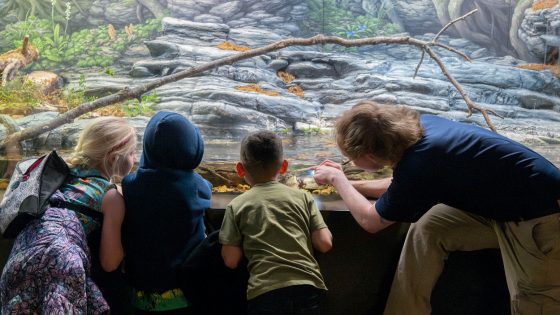
Chris Hollingsworth talks to a group of children visiting the hellbender exhibit at the Saint Louis Zoo’s herpetarium
Hollingsworth credited an animal behavior course, taught by Associate Professor Aimee Dunlap in his second-to-last semester, for helping him realize his passion for zoos and the possibilities that existed in animal care.
As part of the class, Hollingsworth and his classmates took part in a group project where they observed the behavior of multiple species of their choosing. He naturally gravitated toward the herpetarium and convinced his fellow group members to compare the behavior of McCord’s box turtles and Aldabra giant tortoises.
In his visits to the zoo to study the animals, Hollingsworth also had a chance to meet and interact with some of the zookeepers, and he learned about internship opportunities available at the zoo.
He wound up landing one in January 2024, shortly after graduating with both his bachelor’s degree and a certificate from the Pierre Laclede Honors College. He joined the team in the herpetarium, getting trained on different facets of animal care, including how to hook snakes under 8 feet, as well as cleaning exhibits and public spaces.
He also learned about the details that go into each exhibit and its design.
The internship proved an important entry point into a competitive field. He made enough of an impression with his work ethic that Justin Elden, the zoo’s curator of herpetology and aquatics, encouraged him to apply for a paid position.
“We have 10 or 12 interns a year, so not all of them can get part-time jobs here,” Hollingsworth said. “I’m so grateful to my bosses at the herpetarium and for the hellbender keepers that helped interview me for the job and that were willing to offer me the position.”
Hollingsworth has been trying to learn as much as he can since he started last September. He said his position is grant-funded until late 2026, so he expects to remain in his role until then unless a full-time position opens first.
He’d love to remain in St. Louis, but he believes he’ll be well-prepared to work anywhere when it’s time to take the next step in his career.
“A lot of zookeeping jobs right now are very specialized,” Hollingsworth said. “I feel like I’m a salamander specialist, and not only that, I’m also working in a conservation program that’s been around for decades. It’s very well-known, and it’s very successful. If I wanted to apply to a different zoo that has its own conservation program, I can say I helped with this program. I helped make sure it was successful. I helped with a program that we know is working in the wild and has been for over a decade. So, I feel like it’s been an invaluable experience.”



